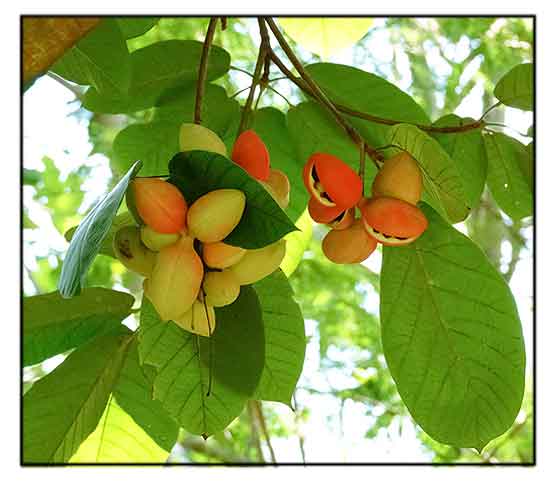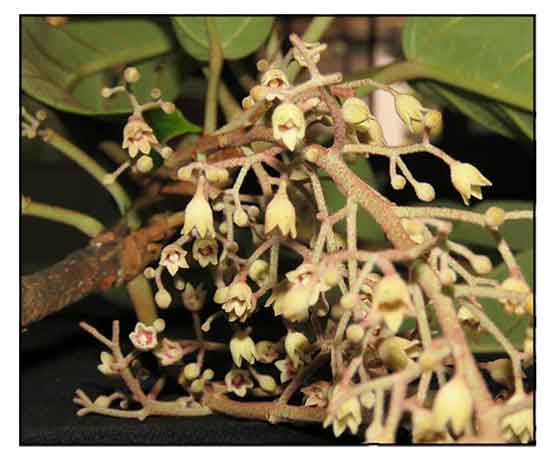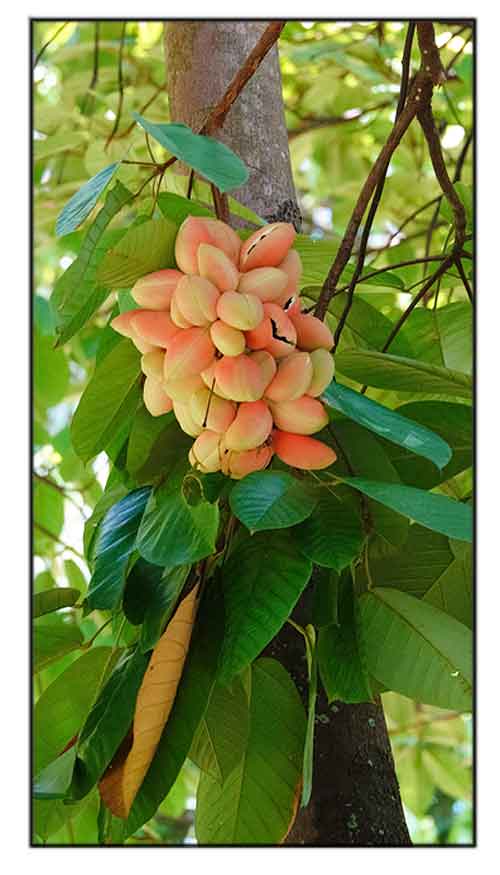 Gen info Gen info
- Sterculia is a genus of flowering plants in the mallow family, Malvaceae: subfamily Sterculioideae (previously placed in the now obsolete Sterculiaceae). Most in the genus are colloquially known as tropical chestnuts. Plants of the World Online lists 182 accepted species. (5)
-
Etymology: Sterculia derives from Sterculius of Roman mythology, the god of manure, which refers to the unpleasant aroma of the flowers of the genus. Species epithet cordata derives from Latin cordatus, meaning "heart shaped", referring to the leaf base.
Botany
• A medium-sized to fairly large tree up to 40 m tall, with bole up to 60 cm in diameter, buttresses el m high and 1.5 m wide, bark surface smooth, finely cracked or sparsely vertically fissured, to roughish, pinkish-brown, pale brown to chocolate-brown, inner bark fibrous, pinkish-brown, pale brown to dark red, twigs slender, 3-5 mm in diameter; leaves simple and entire, ovate, elliptical to elliptical-oblong, (6.5-)16-19(-30) cm x (3-)7-9(-19) cm, generally cordate at base, sometimes rounded, generally densely stellate appressed hairy below, petiole 1.5-4(-9) cm long, stipules lanceolate, caducous; inflorescence axillary or subterminal, paniculate, many-branched, drooping; calyx with obconical tube densely pubescent inside and 5 ligulate or lanceolate recurved or converging lobes slightly longer than the tube and sometimes coherent at apices, male flowers with 8-12 anthers; follicles 2-5, obovoid or sometimes oblong, 4.5-12 cm long, densely yellowish-brown tomentose; seed ellipsoid, 1-2.5 cm long, brown. (2)
Two varieties are distinguished; var. montana (Merr.) Tantra (synonyms: Sterculia montana Merr., Sterculia borneensis Ridley) is found in Borneo and the Philippines and differs from var. cordata (synonym: Sterculia javanica R.Br.) in its converging calyx lobes with coherent apices and its larger seeds. S. cordata occurs in primary and secondary forest up to 1200 m altitude; in Sarawak it is found on fertile clay-rich soils, on alluvium and lower slopes of hills. The wood is pale pinkish-brown darkening towards the centre of the log. (2)
 • Sterculia cordata is a tree that is briefly deciduous, generally to 20 m tall. In Borneo, it can reach to 45 m tall. It has horizontal branches in whorls and short buttresses at the base of the trunk. Foliage: Leaves are simple, spirally arranged and clustered towards the end of the twigs held on a petiole of 2 - 5 cm long covered in dense star-like hairs. The leaves are egg to spoon-shaped to broadly elliptic, measuring 8 - 30 cm long by 5 - 19 cm wide with a shallow heart-shaped to box-shaped base and abrupt to broadly pointed tip. Dense, star-like hairs are found on the underside, the upper surface remains smooth. Flowers: Flowers are monecious where the female and male parts are borne on separate flowers. They are produced in drooping clusters of bell-shaped flowers, pink, reddish to orange colored with a dark red centre. Star-like hairs are found on both sides of the 5-lobed flowers. Female flowers measure at 4 - 8 mm long, slightly larger than male flowers of 3 - 5 mm long. Fruit: Fruit is pendulous, woody, oblong follicle in groups of up to 5, measuring 9 cm long, 5 cm wide. Upon maturity, the fruit turns red and splits open to reveal its dark elliptic seeds. (3) • Sterculia cordata is a tree that is briefly deciduous, generally to 20 m tall. In Borneo, it can reach to 45 m tall. It has horizontal branches in whorls and short buttresses at the base of the trunk. Foliage: Leaves are simple, spirally arranged and clustered towards the end of the twigs held on a petiole of 2 - 5 cm long covered in dense star-like hairs. The leaves are egg to spoon-shaped to broadly elliptic, measuring 8 - 30 cm long by 5 - 19 cm wide with a shallow heart-shaped to box-shaped base and abrupt to broadly pointed tip. Dense, star-like hairs are found on the underside, the upper surface remains smooth. Flowers: Flowers are monecious where the female and male parts are borne on separate flowers. They are produced in drooping clusters of bell-shaped flowers, pink, reddish to orange colored with a dark red centre. Star-like hairs are found on both sides of the 5-lobed flowers. Female flowers measure at 4 - 8 mm long, slightly larger than male flowers of 3 - 5 mm long. Fruit: Fruit is pendulous, woody, oblong follicle in groups of up to 5, measuring 9 cm long, 5 cm wide. Upon maturity, the fruit turns red and splits open to reveal its dark elliptic seeds. (3)
 Distribution Distribution
- Native to the Philippines.
- Also native to Borneo, Jawa, Malaya, Nicobar Is., Thailand. (2)
- In primary forests up to 900 m. Able to grow on limestone soil in the islands.
Constituents
- All extracts and fractions of leaves yielded alkaloid, flavonoid, terpenoid, and tannins. Phenol content was at range of 3.06 to 45.61 mg gallic acid/g; flavonoid content was 25.87 to 36.57 mg quercetin/g. (see study below) (4)
Properties
- Studies have suggest antioxidant, antibacterial, cytotoxic, antithrombotic properties.
Parts used
Leaves.
Uses
Edibility
- No report found on edibility.
Folkloric
- No reported folkloric medicinal use in the Philippines.
Studies
• Antioxidant / Antibacterial / Cytotoxic / Leaves: Study evaluated the medicinal properties of Sterculia cordata leaves extracts with pure ethanol and fractionated with n-hexane, ethyl acetate, chlorofrom, and methanol. All extracts and fractions yielded alkaloid, terpenoid, flavonoid, and tannins. The methanol fraction exhibited strong antioxidant activity in both reducing powers. In antibacterial screening, moderate zone of inhibition (8-12 mm) was observed against gram(+) Bacillus subtillis and 7.8-14 mm against gram(-) Pseudomonas aeruginosa, Escherichia colii, Bacillus cereus and Staphylococcus aureus. In brine shrimp lethality assay, the chloroform fraction showed highest cytotoxic activity with LC50 95.23 mg/ml. (4)
• Antithrombotic / Leaves: Study evaluated leaf extract and fractions of Sterculia cordata for antiithrombotic properties by clot lysis test using standard streptokinase on human blood. Using in-vitro antithrombotic model, all extracts, fractions, and Streptokinase exhibited (p<0.0001) clot lysis. A pure ethanol extract showed highest significant (62.04%) clot lysis activity among all extracts (p<0.0001) compared to negative control and p<0.001 compared to positive control. (6)
Availability
Wild-crafted. |

![]()






